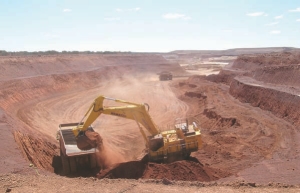VANCOUVER–On the heels ofatemporary mill shutdown in Brazil that dragged its share price down, Troy Resources (TRY-T) rebounded with drill results out of Australia that prompted a 16% share gain.
The Australian-based company cut significant gold in its first deep diamond-drill hole at the Two Mile Hill prospect, part of the Sandstone project in Western Australia. Two Mile Hill sits less than 3 km northeast of the mill at Sandstone.
Assay results from the first 285 metres of hole 34 showed three intercepts: 33 metres grading 1.52 grams gold per tonne from 43 metres down-hole; 11 metres of 1.83 grams gold from 127 metres depth; and 108 metres grading 2.59 grams gold from 177 metres. The third intercept included 3 metres grading 13.51 grams gold.
Assay results are pending from 285 metres to the hole’s termination at 450 metres depth.
The hole targeted an open stock-work of flat-lying quartz veins hosted in a tonalite intrusive, and remained within tonalite over its entire length. The core showed quartz vein intersections throughout its entire length and contained 30 occurrences of visible gold, primarily within narrow quartz veins.
Troy has traced the tonalite laterally along a 200-metre strike length and to 50 metres width, however the extent of quartz vein-hosted mineralization within the intrusive rock is not yet known. A second hole, hole 727, was collared 80 metres south and 100 metres east of hole
34. Itwas designed totest the tonalite as well as the projected intersections of a banded iron formation near the intrusive contact on the eastern margin.
The hole cutthrough basalt highly altered by silica, carbonate and pyrite to 258 metres depth, where it hit the contorted, siliceous, pyrite and magnetite-bearing banded iron formation until 306 metres depth. From there until the hole’s termination at 403 metres, the core showed tonalite, which carried 11 occurrences of visible gold within quartz veins.
Since taking over operations at Sandstone in 1999, Troy has mined out the Bulchina, Lord Nelson and Lord Henry pits. The latter two pits were exhausted in December 2007, at which time 700,000 tonnes of ore from the Lord pits had been stockpiled at the mill. Troy expected to process that ore over the following 18 months.
Results from hole 34 buoyed Troy’s share price by 33, or 16%, to $2.40. It was a well-timed gain, as the previous day saw a 12 drop on news that Troy had temporarily shut down its Brazilian gold mill.
Troy poured its first gold dor bar at its Andorinhas mine in Para state in mid-March following successful commissioning of the facility’sfirst ball mill. Less than a month later, a power surge during an intense electrical storm burned out one phase of the mill’s motor winding and forced Troy to shut the mill down. The company removed the motor and sent it for repair, estimating that repairs would take roughly two weeks.
The storm activity is part of an unusually long and severe wet season at Andorinhas that has also slowed completion of the second ball mill. The company had expected to commission the second mill in April but now anticipates it will have to wait until May.
In the meantime Troy will continue advancing the decline access to the high-grade Mamao deposit. First ore production from Mamao is expected by the end of July. Troy is currently mining ore from the Lagoa Seca open pit.
The company bought the property as an in-situ resource in late 2006 for US$10.4million and started production 16 months later for an initial capital cost of US$15.5 million. Once at full production, Andorinhas is expected to produce 50,000 oz. gold per year over a mine life of at least five years.
The project has probable reserves of 1.2 million tonnes grading 6.51 grams gold for about 255,000 oz. gold. Troy hopes to lengthen that mine life through exploration and recently nearly doubled its land position through a joint venture with Horizonte Minerals (HZM-L).
The JV agreement allows Troy to gain a 100% interest in Horizonte’s neighbouring Tangara project by paying US$800,000 and spending US$2 million on exploration over three years. Troy would also have topayaproduction royalty of US$30 per oz. gold up to 500,000 oz.; after that Horizonte would retain a 1% net smelter return (NSR) royalty up to 1 million oz. gold and a 2% NSR on production beyond 1 million oz.
Troy listed on the Toronto Stock Exchange in January after raising $22 million in its initial public offering, in which it sold some 8.5 million shares at $2.60 each. Since then Troy’s share price has ranged from $1.90 to $2.81. The company has 69.8 million shares issued.


Be the first to comment on "Troy jumps on golden hole Down Under (April 21, 2008)"